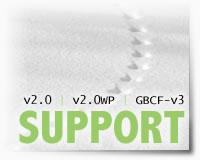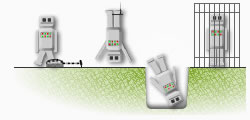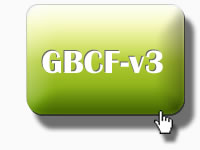The following entries were made in the “All Things PHP” category.
Archive for “All Things PHP”
New Contact Form Support Post
 If you need support for my version 2.0, 2.0WP, or GBCF-v3 contact form scripts, this is the place to get it. The new place. I’ve used the same blog posts for contact form support comments and questions for such a long time, their pages have gotten long. Really long! I decided to start a new one and just close those. That said, those old posts have not stopped living their useful lives. Many of your questions may already be answered there, read them first.
If you need support for my version 2.0, 2.0WP, or GBCF-v3 contact form scripts, this is the place to get it. The new place. I’ve used the same blog posts for contact form support comments and questions for such a long time, their pages have gotten long. Really long! I decided to start a new one and just close those. That said, those old posts have not stopped living their useful lives. Many of your questions may already be answered there, read them first.
Support Update: Header not recognized with the WordPress plugin? Did you unzip the zip file first?
Continue reading “New Contact Form Support Post” »
Protecting Forms from Spam ‘Bots
 Spam robots or spam ‘bots abuse comment forms, contact forms, and any forms they can. A true scourge of the web. They exploit insecure forms to send spam. Fortunately there are individual methods of slowing them down. And when used jointly, ‘bots can actually be stopped. This post shares four scripted operations I’ve found particularly helpful to prevent illegitimate posting. In the following examples, at least one variable will be posted, and will appear in this article as
Spam robots or spam ‘bots abuse comment forms, contact forms, and any forms they can. A true scourge of the web. They exploit insecure forms to send spam. Fortunately there are individual methods of slowing them down. And when used jointly, ‘bots can actually be stopped. This post shares four scripted operations I’ve found particularly helpful to prevent illegitimate posting. In the following examples, at least one variable will be posted, and will appear in this article as $posted_var (meaning it’s captured by $_POST['var']) to offer greater clarity, but this variable can be whatever you need it to be: name, email, etc.
Continue reading “Protecting Forms from Spam ‘Bots” »
Making the WordPress Menu Smarter
Why do this? Consistency, style, and usability. It’s a progressive enhancement.
It was almost a year ago that I published the article “Building a Dynamic WordPress Nav Menu” in which I described the how-to of my BeastBlog v2 theme’s navigation menu. I thought I’d revisit the subject since it’s been revisited through my projects lately. The menu’s gotten smarter. This won’t be needed on many sites, and WordPress blogs without “pages” wouldn’t need this, but on others it might be a nice enhancement. That’s your call.
Continue reading “Making the WordPress Menu Smarter” »
Secure and Accessible Contact Form v3
 I’m happy to announce the availability of version three of my GBCF-v3 Secure and Accessible Contact Form. It offers a ton of improvements over version two in the areas of perfected error management, easy language adaptability, passive set-up validation assistance — so the script can be tested before putting it on your site — security, usability, powerful flexibility, and enhanced accessibility. On this last front two notable features include: the form’s ability to automatically adapt to the user’s preferences maintaining the semantics and accessibility and; the form’s refined usage of labels and legends to make the experience of using the form a smart one for screen reader users.
I’m happy to announce the availability of version three of my GBCF-v3 Secure and Accessible Contact Form. It offers a ton of improvements over version two in the areas of perfected error management, easy language adaptability, passive set-up validation assistance — so the script can be tested before putting it on your site — security, usability, powerful flexibility, and enhanced accessibility. On this last front two notable features include: the form’s ability to automatically adapt to the user’s preferences maintaining the semantics and accessibility and; the form’s refined usage of labels and legends to make the experience of using the form a smart one for screen reader users.
Continue reading “Secure and Accessible Contact Form v3” »
The Whatever Plugins for WordPress
Set up is a breeze: Copy it. Save it. Load it. Activate it. Use it for whatever.
If you’ve ever wanted an extra page for whatever in your WordPress admin, this is one way to get your wish. On this page you’ll find two scripts for a couple of open-ended plugins. One is the Whatever plugin, and the second one will give you a head start by offering you a Whatever Links plugin script. To use these scripts, just follow the simple instructions at the end of this post. These plugins should work without a problem on all (see comments) current WordPress versions. The protected content these plugins afford could be had via a password protected post or page, but this is more convenient as there’s a single login only and it’s rights managed.
Continue reading “The Whatever Plugins for WordPress” »
Introducing PHP AutoRun and a CSS Tutorial
 I’m making two announcements for the price of one today: One is the completion of my PHP AutoRun System; The second is my first use of the AutoRun system in the making of this “How to Make a CSS Web Site” tutorial. The idea for this goes back at least six months. It took me a while to make it happen because it’s, well, pretty involved, and I’m a busy guy. Finally, though, I have completed this project. I’ll explain here what these two things are all about and maybe get some [hopefully positive] comments and feedback.
I’m making two announcements for the price of one today: One is the completion of my PHP AutoRun System; The second is my first use of the AutoRun system in the making of this “How to Make a CSS Web Site” tutorial. The idea for this goes back at least six months. It took me a while to make it happen because it’s, well, pretty involved, and I’m a busy guy. Finally, though, I have completed this project. I’ll explain here what these two things are all about and maybe get some [hopefully positive] comments and feedback.
Continue reading “Introducing PHP AutoRun and a CSS Tutorial” »
Building a Dynamic WordPress Nav Menu
 More and more people are using WordPress as a Content Management System (CMS), and for good reason. It’s well supported, produces good mark-up, and it’s flexible. But when using it as a CMS it suddenly becomes very important to optimize the support of WordPress “Pages.” Unlike post, archive, and category links, a web site’s “Pages” have the utmost importance. This article will teach you how to produce a dynamic WordPress “Pages” navigation menu that looks good and behaves as a main navigation menu should.
More and more people are using WordPress as a Content Management System (CMS), and for good reason. It’s well supported, produces good mark-up, and it’s flexible. But when using it as a CMS it suddenly becomes very important to optimize the support of WordPress “Pages.” Unlike post, archive, and category links, a web site’s “Pages” have the utmost importance. This article will teach you how to produce a dynamic WordPress “Pages” navigation menu that looks good and behaves as a main navigation menu should.
Continue reading “Building a Dynamic WordPress Nav Menu” »
Enhancing the WordPress Title Element
 I have written about page titles in WordPress before, but when I made my new theme I found another alternative. I feel this method provides slightly better results across a wider range of installations.
I have written about page titles in WordPress before, but when I made my new theme I found another alternative. I feel this method provides slightly better results across a wider range of installations.
In the header.php file you need to look for the title element. It looks like this: <title></title>, but this is the element only, shown without its content. What you’ll probably see is this code (on one line):
Continue reading “Enhancing the WordPress Title Element” »
Posting Author Info in WordPress
 On this page, any page with a sidebar, you’ll notice a little “Blog Author” box (see right). Big deal, right? Well, what’s cool is how I got it there. It’s a feature I added to my latest WordPress theme. I think it’s neat. Since it can be implemented on any theme it is worth noting with an explanation of how other WordPress users can use the feature. I’ve logged into quite a few blog admin areas to know it’s under-utilized but this short tutorial may change that.
On this page, any page with a sidebar, you’ll notice a little “Blog Author” box (see right). Big deal, right? Well, what’s cool is how I got it there. It’s a feature I added to my latest WordPress theme. I think it’s neat. Since it can be implemented on any theme it is worth noting with an explanation of how other WordPress users can use the feature. I’ve logged into quite a few blog admin areas to know it’s under-utilized but this short tutorial may change that.
Continue reading “Posting Author Info in WordPress” »

